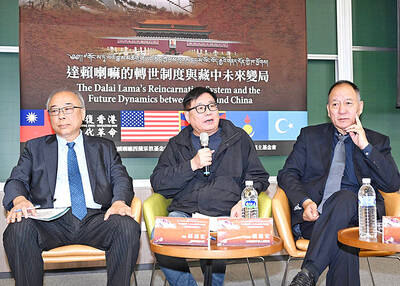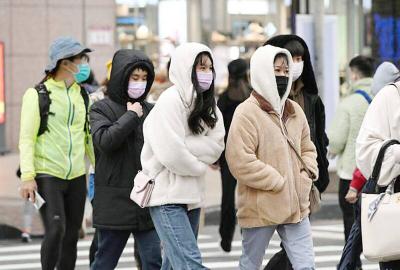CPC Corp, Taiwan’s (CPC, 台灣中油) development of a new liquefied gas terminal should not be affected by the government’s plans to abandon nuclear energy by 2025, Environmental Protection Administration (EPA) Deputy Minister Chan Shun-kuei (詹順貴) said at a forum in Taipei yesterday.
Under the policy, the government hopes to phase out the nation’s three operational nuclear power plants and generate 50 percent of the nation’s electricity from natural gas, 30 percent from coal and 20 percent from renewable sources by 2025.
State-run utility CPC plans to build its third liquefied gas terminal on yet-to-be reclaimed land off the coast of Datan Borough (大潭) in Taoyuan’s Guantang Industrial Park, but biologists have said the project would damage protected coral species Polycyathus chaishanensis in the area, as well as a wide stretch of algal reef.
While CPC has said many times that delaying development of the terminal would impede plans to go nuclear-free, Chan said the government should instead consider adjusting the ratio of energy sources to accommodate the shutdown of the nuclear plants.
The government could reduce the planned ratio of natural gas to 32.4 percent, reduce renewables, oil-fired plants and other sources of electricity to 10.2 percent, and increase coal-fired power to 45.4 percent, while maintaining power generated from nuclear energy at 12 percent, Chan said.
The ratio adjustment was his personal suggestion, not a conclusion reached after a discussion with the Executive Yuan, Chan said in response to questions.
The EPA has received CPC’s new strategy for minimizing the project’s ecological impact and is to convene a review meeting on Oct. 26, he said.
The critical issue for the EPA’s review committee is whether transplanting individual species without affecting the entire ecosystem is technically feasible and how the company could verify that, Chan said.
The Port of Taipei in New Taipei City’s Bali District (八里) is the best location for the terminal, National Chung Hsing University environmental engineering professor Tsuang Ben-jei (莊秉潔) said, adding that “those who do not choose it are idiots.”
The wind speed in Datan often surpasses 12 meters per second, meaning that there are only about 249 days per year during which liquefied natural gas tankers can safely enter the port, Tsuang said.
Wind speeds at the Port of Taipei are lower, allowing entry 334 days per year, Tsuang said.
Also speaking at the forum, CPC vice president J.Z. Fang (方振仁) admitted that weather conditions are worse at the industrial park than at the Port of Taipei.
However, if the terminal is to be built at the Port of Taipei, the company would have to reclaim land from the sea and complete a new environmental impact assessment, Fang said, adding that such a terminal would begin to supply gas in 2028 instead of 2022.
“Although there is no algal reef issue at the Port of Taipei, local residents [in Bali] are opposed to the terminal project,” he said.
With Datan as its priority location, the company plans to transplant the algal reef on Datan’s coast to the Guansin (觀新) reefs ecological conservation area to the south, he said, adding that CPC would continue to evaluate the feasibility of transplanting the endangered coral.
The forum, which aimed to find a “win-win solution” to the issue, was jointly organized by the Academia Sinica Biodiversity Research Center, Taoyuan Local Union, Environmental Jurists Association, Wild at Heart Legal Defense Association, Taiwan Environmental Protection Union and Taipei Bar Association at the Chinese Culture University in Taipei and was attended by about 20 speakers and 100 people.

ALIGNED THINKING: Taiwan and Japan have a mutual interest in trade, culture and engineering, and can work together for stability, Cho Jung-tai said Taiwan and Japan are two like-minded countries willing to work together to form a “safety barrier” in the Indo-Pacific region, Premier Cho Jung-tai (卓榮泰) yesterday said at the opening ceremony of the 35th Taiwan-Japan Modern Engineering and Technology Symposium in Taipei. Taiwan and Japan are close geographically and closer emotionally, he added. Citing the overflowing of a barrier lake in the Mataian River (馬太鞍溪) in September, Cho said the submersible water level sensors given by Japan during the disaster helped Taiwan monitor the lake’s water levels more accurately. Japan also provided a lot of vaccines early in the outbreak of the COVID-19 pandemic,

Kaohsiung Mayor Chen Chi-mai (陳其邁) on Monday announced light shows and themed traffic lights to welcome fans of South Korean pop group Twice to the port city. The group is to play Kaohsiung on Saturday as part of its “This Is For” world tour. It would be the group’s first performance in Taiwan since its debut 10 years ago. The all-female group consists of five South Koreans, three Japanese and Tainan’s Chou Tzu-yu (周子瑜), the first Taiwan-born and raised member of a South Korean girl group. To promote the group’s arrival, the city has been holding a series of events, including a pop-up

TEMPORAL/SPIRITUAL: Beijing’s claim that the next Buddhist leader must come from China is a heavy-handed political maneuver that will fall flat-faced, experts said China’s requirement that the Dalai Lama’s reincarnation to be born in China and approved by Beijing has drawn criticism, with experts at a forum in Taipei yesterday saying that if Beijing were to put forth its own Dalai Lama, the person would not be recognized by the Tibetan Buddhist community. The experts made a remarks at the two-day forum hosted by the Tibet Religious Foundation of His Holiness the Dalai Lama titled: “The Snow Land Forum: Finding Common Ground on Tibet.” China says it has the right to determine the Dalai Lama’s reincarnation, as it claims sovereignty over Tibet since ancient times,

Temperatures in some parts of Taiwan are expected to fall sharply to lows of 15°C later this week as seasonal northeasterly winds strengthen, the Central Weather Administration (CWA) said today. It is to be the strongest cold wave to affect northern Taiwan this autumn, while Chiayi County in the southwest and some parts of central Taiwan are likely to also see lower temperatures due to radiational cooling, which occurs under conditions of clear skies, light winds and dry weather, the CWA said. Across Taiwan, temperatures are to fall gradually this week, dropping to 15°C to 16°C in the early hours of Wednesday